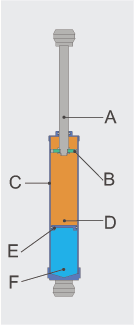The problem with a lowrider is that things like speed bumps and rough roads can make driving difficult. To solve these problems, lowrider enthusiasts install car hydraulics lift kits that allow a completely adjustable height for the vehicle. These kits use electric car hydraulics pumps and normal hydraulic cylinders to raise and lower the vehicle. Imagine connecting the cylinder alongside the shock absorber or the spring, and you get the idea. It's a pretty involved installation and can cost several thousand dollars.
So the car hydraulics solved the height problem.
What happened next was unpredictable and amazing -- it's one of those strange things that can happen in an evolutionary process. Someone, at some point, realized that with enough power, the hydraulics system could make the car hop! The financial ability to buy car hydraulics and install them an innovation in and of itself took the lowrider to a whole new level.
Car hydraulics systems quickly evolved to make hopping more and more interesting,
 Image via Wikipedia
Image via Wikipedia
Lowriders feature car hydraulics suspension systems that allow the driver to alter the ride height at will. These systems range from simple to complex and are usually measured by the amount of switches used to control the various hydraulics combinations that ultimately produce a specific motion from the car. The most common motions are dipping/raising the four corners of the car (referred to as corners), dipping/raising the front or rear of the car (front, back), dipping/raising the sides of the car (side to side), and lowering/raising the car as a whole (pancake). A skilled switch operator can manipulate his car hydraulics controls (hitting switches) to raise one wheel completely off the ground (3-wheel motion), or to bounce one end of the car completely off the ground.
Nobody knows exactly what inspired these original lowrider owners to lower their cars. The rear end and front suspension are lowered, its tires are skimpy and its motor is usually left untouched. Another mark of a lowrider is its extravagant amount of accessories, such as chrome pipes, wheel skirts and window visors that can be costly.In 1957, Gov. Edmond Brown outlawed lowrider cars. The California law prohibits drivers from lowering the frame of the car past the lowest point of the wheel rim. Because back then they had only stock tires, the car was usually about 5 inches off the ground and that just wasn't low enough. An enterprising Chicano by the name of Richard Aguirre, tired of getting tickets for his illegally lowered car, figured out a way to lower and raise his car using aircraft hydraulic pumps which he turned into a car hydraulics system.
Since then, lowriders began installing car hydraulics so that a car that seems to be only two or three inches of the ground can be raised to eight or 10 inches to go over curbs, railroad tracks or past a police car. Lowriders that are lifted with car hydraulics usually have separate systems for the front and the back, each running off two or three batteries kept in the trunk of the car.
Later, Aguirre’s ideas for car hydraulics were redesigned to lift the front and rear tires off the ground. So by carefully timing the jolts of electricity to the front-end hydraulics, the driver can actually bounce the front wheels of his car off the ground.
When a lowrider switches off its headlights at night the shower of sparks flying from the car are not gun shots. They’re caused when the front of the car is lowered and dragged over the pavement, screeching along on a scrap plate that has been welded to the frame of the car.
![Reblog this post [with Zemanta]](http://img.zemanta.com/reblog_e.png?x-id=12e19c81-be77-4da6-a9c3-66818bbfb899)

![Reblog this post [with Zemanta]](http://img.zemanta.com/reblog_e.png?x-id=c40ce4cb-b856-4abd-bdf3-adf818bd8acb)